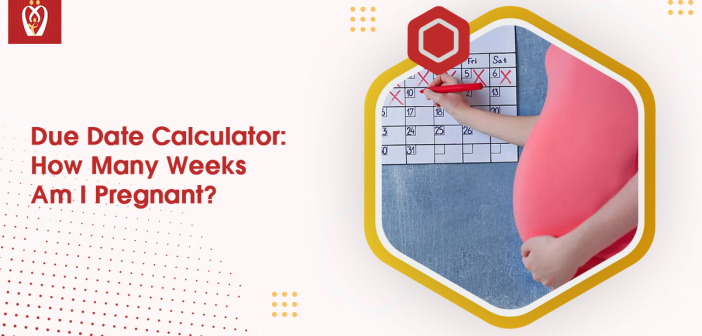There is no bigger thrill than taking a pregnancy test and getting a positive result! After you’ve processed the news, the first question that will undoubtedly cross your mind is, “When is my due date?” While it is true that most pregnancies last 40 weeks, there are various other factors to consider when calculating your due date.
With the pregnancy due to date calculator, we can put your worries to an end and help you know your estimated due date.
Due Date Calculator: How Many Weeks Am I in My Pregnancy?
The estimated date of delivery (EDD), also known as the due date, is when one can expect the labor to start. This date can be determined using a pregnancy due to date calculator. However, it’s only an estimate, and only one out of every 20 women gives birth on their estimated due date. You’ll most likely begin labor two weeks before and after your due date.
Gestational Age Vs Fetal Age
There are two ways to calculate a baby’s age during pregnancy:
- Gestational Age
- Fetal Age
Gestational age tracks pregnancy and determines the due date. It calculates your pregnancy’s progress in weeks, whereas fetal age is the actual age of the growing baby.
Gestation is the period between conception and birth. It calculates the time dividing your last menstrual period (LMP) — the first day of your last period — by the current date.
How Do I Calculate the Due Date?
A due date calculator calculates your expected due date using four methods:
- Due date by the last menstrual period
- Due date by conception date or ovulation
- Due date by IVF transfer date
- Due date by ultrasound scan
Due Date Calculator: Last Menstrual Period
The average pregnancy lasts 280 days or nine months. The due date calculator calculates the results by adding 280 days to the first day of your last period.
This method assumes a regular 28-day cycle (cycles can range from 20 to 45 days), with the menstrual period and ovulation happening during the first two weeks of pregnancy. This method is not perfect because it depends on the regularity of your menstrual cycle.
We have compiled all of the details on these advanced formulas a due date calculator uses to produce the most accurate results.
Naegele’s Rule
- The standard method for calculating a pregnancy’s due date
- Due date= LMP + 280 days
- It regards a 28-day menstrual cycle to be 28 days, with ovulation occurring around the 14th day of the cycle
- The estimated due date for a longer cycle will be later.
- The estimated due date will be earlier for a shorter cycle.
Mittendorf-Williams Rule
- More advanced than Naegele’s rule
- An average of 288 days from LMP for first pregnancies
- In subsequent pregnancies, the average time from LMP is 283 days.
- For first pregnancies, due date= LMP – 3 months + 15 days
- For subsequent pregnancies, due date= LMP – 3 months + 10 days
Parikh’s Rule
- Used for irregular cycles
- Due date= LMP + 280 days – 21 days + the length of previous cycles (or the average cycle length)
- It reduces the possibility of any potential errors in calculating your expected due date.
Wood’s Rule
- Considers both the length of the menstrual cycle and the number of pregnancies
- Expected due to date calculation
For first pregnancies= LMP + 12 months – (2 months and 14 days)
For subsequent pregnancies= LMP + 12 months – (2 months and 18 days)
- In the equation, enter the expected due date based on the length of your cycle.
For cycles lasting more than 28 days, due date= EDD + (actual length of cycle – 28 days)
For cycles shorter than 28 days, due date= EDD – (28 days – the actual length of your menstrual cycle)
Due Date Calculator: Conception Date
You can use the IVF due date calculator to estimate your due date if you are among the IVF mothers.
The IVF due date calculator can calculate the due date of your baby in two ways:
- Your due date will be 266 days (or 38 weeks) later from your IUI day if you undergo IUI (intrauterine insemination)
- The due date is 263 days from the transfer day for a three-day embryo. Add 261 days to your due date for a five-day embryo transfer.
Due Date Calculator: Ultrasound Scan
According to OBG’s, the first-trimester ultrasound method is the most accurate to verify gestational age. Thus, you can confirm your due date at your first prenatal appointment. If you can’t remember when you conceived, missed your last period, or when ovulation occurred. The midwife will measure the baby’s length from crown to rump to determine how far along you are and calculate your due date. Your general practitioner will change your due date if the baby is noticeably bigger or smaller than expected for the gestational age based on your LMP.
Schedule your Appointment with the Nurturey Pregnancy App
Schedule an ultrasound appointment with your midwife using the Nurturey Pregnancy App and confirm the pregnancy.
Also, the Nurturey pregnancy app uses cutting-edge technology like AI, analytics, and virtual reality to provide you with a parenting experience worth millions of hours at your fingertips. The Nurturey PinkBook is a system for managing pregnancy and child health and the best alternative for the NHS paper red book. To seize advantage of the digital upgrade for the NHS paper red book, download the Nurturey pregnancy app from the App Store or Google Play.
Final Thoughts on the Due Date Calculator
The average pregnancy lasts 282 days (40 weeks) from the start of your last period. However, babies rarely stick to a strict schedule. A full-term pregnancy can last between 37 and 42 weeks. Our due date calculator will help you determine the most accurate due date. So relax and enjoy the pregnancy because you’ll soon be experiencing parenthood bliss!







